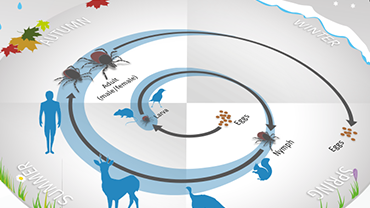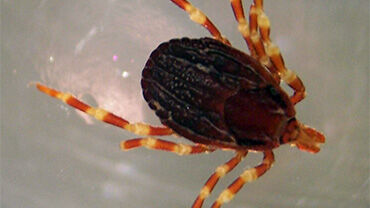Tick-borne diseases
Ticks are abundant in woodlands all across Europe from early spring to late autumn. They live by sucking blood from animals and occasionally bite humans.
Ticks themselves do not cause disease but if a tick is infected with a virus or bacterium, then that pathogen can be transmitted through the tick’s bite and cause disease in humans.
Tick-borne encephalitis (TBE) is a common tick-borne disease in Europe (along with Lyme borreliosis).
Latest outputs
Tick-borne diseases
Topic page
Alkhurma haemorrhagic fever
Alkhurma haemorrhagic fever is a viral haemorrhagic disease reported mainly in Saudi Arabia. Transmission is through tick bites and contact with infected blood.
Topic page
Babesiosis
Information on basesiosis, a disease spread by ticks, with facts, prevention tips, infographics, and tick maps.
Topic page
Borreliosis (Lyme disease)
Borreliosis, also known as Lyme disease, is transmitted by the bite of infected ticks. Most cases can be treated with antibiotics. No vaccine is available.
Topic page
Crimean-Congo haemorrhagic fever
Crimean-Congo haemorrhagic fever is an emerging pathogen in Europe. Outbreaks have a case fatality rate between 5% and 40%. There is no validated therapy and no safe vaccine.
Topic page
Human granulocytic anaplasmosis
Human granulocytic anaplasmosis (HGA) is a tick-borne infection caused by the bacterium Anaplasma phagocytophilum, a small bacterium infecting typically neutrophils transmitted by Ixodes ticks.
Topic page
Rickettsiosis
Rickettsiosis/rickettsioses are a group of diseases generally caused by species of Rickettsia. Most of the Rickettsioses are transmitted by ticks.
Topic page
Tick-borne encephalitis
Tickborne encephalitis (TBE) is a viral infectious disease that attacks the central nervous system and can result in long-term neurological symptoms, and even death.
Topic page
Tick-borne relapsing fever
Tick-borne relapsing fever is transmitted to humans through the bite of infected soft ticks. The disease is characterised by relapsing or recurring episodes of fever, often accompanied by headache, muscle and joint aches and nausea.






